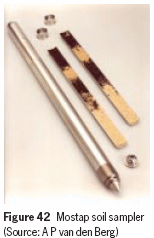Buy the Book
Published By Lankelma
Lankelma is the foremost contractor for onshore in-situ soil testing in the UK. An acknowledged
specialist in CPT, Lankelma also offers a worldwide consultancy and training service.
A.P. van den Berg develops, designs and manufactures geotechnical and environmental soil
investigation equipment for onshore and offshore applications. Specialists in CPT systems and equipment.
Gardline
Gardline Geosciences offers worldwide marine geotechnics, in-house consutancy and services with marine
investigations ranging from nearshore to full ocean depth (down to 3000m).
About the Author
Hans Brouwer studied civil engineering at Delft University in The Netherlands. He has
worked as a part-time lecturer at Amsterdam Polytechnic and was senior partner in a structural
engineering consultancy. He has written a standard textbook in Dutch about the design of
building foundations. He now lives in England where he writes technical textbooks in
English, hopefully to reach a bigger readership.
Quick Links:
Chapter 5
Sampling probes
Mostap soil sampler
MOSTAP SOIL SAMPLER 5.1 |
 |
General principles
The Mostap sampler (Figure 42) enables undisturbed soil samples to be recovered at at chosen depths at a test location. The available sample diameters are 35 and 65 mm, with sample lengths of 1, 1.5 and 2 m.
The advantage of the Mostap sampler, compared with conventional open-tube sampling systems, is that you can take samples at different depths without the need to pre-drill.
Operation
A Mostap sampler consists of a cone plus a cutting mouth at the base, connected to a sample tube, plastic liner and woven stocking. This is connected to standard CPT rods and pushed, using the hydraulic rams, either directly from surface or to a predetermined depth.
|
| |
A fishing tool (ie a line with a hook) is lowered through the hollow rods to release the cone face. The apparatus is then pushed to the required depth, with the sample being wrapped by the woven stocking while being drawn-up inside the plastic liner. During sample recovery the released cone stays in the top part of the sample tube. The sampler is fitted out with a core catcher.
Upon withdrawing the probe, the equipment is dismantled allowing the sample to be retrieved, including the 200 mm section in the cutting head. The tube sample is capped and sealed at both ends, with the cutting shoe sample being retained in an airtight container. Both of these are labelled to identify location, depth, orientation (top and bottom) and details as to whether the sample may
be contaminated. The equipment is thoroughly cleaned, reassembled and is ready for the next sample to be taken.
Specifications
35 mm diameter Pushed in using 36 mm CPT rods. This is mainly
used solely for visual identification purposes, plus confirmation of soil
types. It is not suitable for many geotechnical tests, but can be used for
classification tests: particle index (PI), moisture content (MC) and
particle size distribution (PSD). It is also possible to perform pH and
total sulphate (SO4) tests, and ICRCL contamination suites.
65 mm diameter Pushed in with 55 mm CPT rods. This enables
visual identification and the above mentioned contamination tests to be
carried out, together with the following laboratory tests: MC, Atterberg
limits, bulk density, oedometer, unconsolidated undrained (UU),
consolidated isotropic undrained (CIU) and anisotropic consolidated
undrained triaxial (CAU).
Advantages
The main advantages of the Mostap sampling system are as follows.
- Samples can be collected at selected depths – no pre-drilling is
required
- Samples are of high quality
- No soil arisings are generated – soil is either within the sample tube
or pushed aside as the sampler is advanced
- The system is virtually self-sealed – minimal contact between the
operator and the soil (excellent for preventing contamination of soil
samples)
- Samples can be recovered from both loose-to-dense granular soils
and very soft-to-very stiff cohesive soils.
|
| |
|
<< Previous PageNext Page >>

